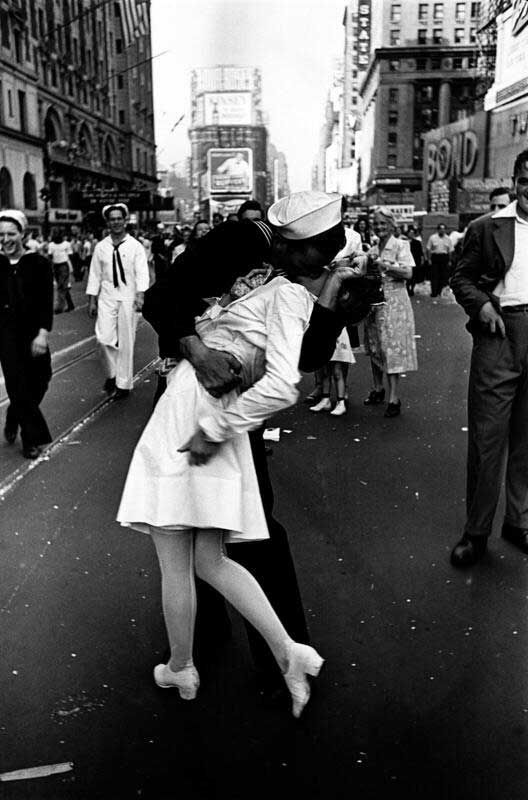THE LEGEND LIVES ON
100 years of Leica photography
History can be written – or photographed. For 100 years now, famous photographers from around the world have been capturing once-in-a-lifetime moments with their Leica camera. Moments that remain unforgettable.
Perhaps the most famous of all timeless, iconic photos can be seen in our film. So go on a journey through time with Leica. With impressive pictures that you can rediscover every time you view them. And which you will never forget.

The flag of victory – Yevgeny Khaldei, 1945

Flood in Wetzlar – Oskar Barnack, 1920

The stolen sword – Robert Lebeck, 1960

V-J Day – Alfred Eisenstaedt, 1945

Muhammad Ali – Thomas Hoepker, 1966

James Dean on Times Square –Dennis Stock, 1955

Le Peintre de la Tour Eiffel – Marc Riboud, 1953
Leica Heritage & The Evolution of The Legendary Leicas
We at Leica don’t just build cameras – we create everlasting values that set standards. The secret to our success? Ingenious engineering and formidable craftsmanship. The result? Timeless classic products. Astonishing innovations. Technical masterpieces. Gain your own glimpse of how the Leica story of success began – and continues today.

1849
In 1849, Carl Kellner founded Optical Institute ("Optisches Institut") in Wetzlar for the production of lenses and microscopes. Kellner had invented a new achromatic combination of lenses for an eyepiece, published in his treatise Das orthoskopische Ocular, eine neu erfundene achromatische Linsencombination, that was able to produce an image with correct perspective and without the distortions that were usual for other optical instruments of the time. The design still is in use today in binoculars.

1865
In 1865, Ernst Leitz was hired as an engineer who later became a partner and took over the company, renaming it Ernst Leitz GmbH.

1907
Between 1889 and 1911, the Leitz company introduced still projectors, cinematic projectors, binoculars, and other optical equipment to their line of goods.
The first binocular was launched in 1907.

1911
Before 1914, cameras were big and bulky.
In 1905, Oskar Barnack had the idea of reducing the format of negative and enlarging the pictures later. He was later hired by Ernst Leitz in 1911, as the Director of Research, with a goal to design an easily portable camera.

1914
THE BIG BANGOskar Barnack invents the Ur-Leica
The construction of the first, fully functional prototype of a revolutionary new still picture camera for 35 mm perforated film was completed by Oskar Barnack in March 1914. The camera had a full metal body, a collapsible lens and a focal plane shutter, which, at the time, had no overlapping curtains. A cap, fixed to the lens by a screw, was swung across the lens when winding on the film to prevent light getting in. The Ur-Leica was the first camera to feature coupled film winding and shutter cocking – thus preventing double exposures. The camera took its place as a milestone in the history of photography under the name ‘Ur-Leica’.

1925
A SERIES OF SUCCESSThe Leica I is presented to the public
The refined and improved version of Barnack’s camera went into serial production under the name of Leica (Leitz Camera) and was presented to the public in March 1925, at the Leipzig Spring Fair. It was fitted with a non-interchangeable, Leitz Anastigmat 50 mm f/3.5 lens designed by Max Berek in a collapsible mount. Soon afterwards, the lens was given the name Elmax (Ernst Leitz, Max Berek). In the same year, Berek employed a new glass type in his design for the Elmar 50 mm f/3.5 – a lens that was to become as world famous as the Leica itself.

1932
BETTER MEASUREDThe Leica II with integrated rangefinder
Oskar Barnack took a decisive step forward by integrating a rangefinder coupled with interchangeable, screw-mount lenses in the body of the Leica. The principle of this characteristic feature of the Leica camera was maintained for all screw-mount cameras with an integrated rangefinder until 1957. At that time, seven interchangeable lenses designed by Max Berek were available for the Leica system.

1954
M STANDS FOR MILESTONE
The Leica M3 is the epitome of the M system even today
The completely new camera construction featured a combined bright-line viewfinder/rangefinder with automatic parallax compensation and automatically displayed bright-line frames for the area covered by 50, 90 and 135 mm lenses, a bayonet mount for interchangeable lenses and a non-rotating shutter speed dial with click stops. An exposure meter that could be attached to the accessory shoe and coupled to the shutter speed dial was also available as an optional accessory. Film winding also became much easier by the replacement of the winding knob with a rapid wind lever. The Leica M3 is the reference model for all M-Cameras constructed to this day.

1984
COMEBACK OF THE YEARThe Leica M6 brings the rangefinder system back to life
The first successful integration of TTL exposure metering and an LED viewfinder display in a classic Leica M body. The camera heralded the renaissance of the Leica rangefinder system in a market dominated by single-lens reflex cameras.

2006
RESPECTThe Leica M8 is the first digital M model
The Leica M8, the first digital M, featured a 10.3 megapixel, low-noise CCD image sensor. All generations of Leica M-Lenses could be mounted on the camera, as long as they did not extend too far into the body. The viewfinder showed bright-line frames for six focal lengths: 24 and 35 mm, 28 and 90 mm and 50 and 75 mm. With a size of 18x27 mm, the sensor of the Leica M8 was smaller than the usual 35 mm format, which meant that Leica lenses captured a correspondingly smaller image field. This difference is expressed by the so-called format or crop factor, which was 1.33 in the case of the Leica M8.

